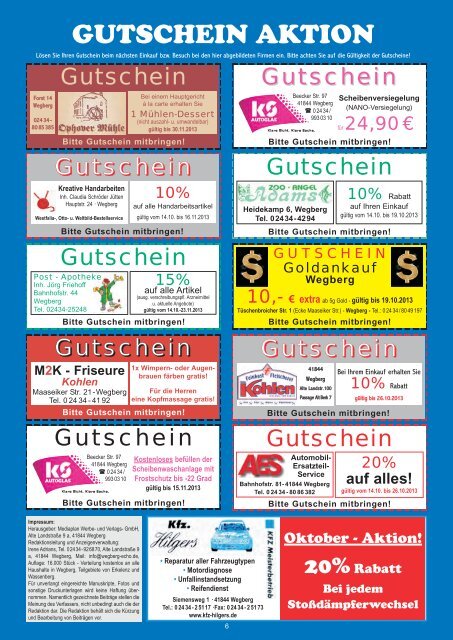Wegberg Echo 06-13.qxd
Wegberg Echo 06-13.qxd
Wegberg Echo 06-13.qxd
- Keine Tags gefunden...
Erfolgreiche ePaper selbst erstellen
Machen Sie aus Ihren PDF Publikationen ein blätterbares Flipbook mit unserer einzigartigen Google optimierten e-Paper Software.
Delayed Nausea and Vomiting Reduce QoLon QoL. This finding, although not unexpected, has not, to ourknowledge, been described previously. Nonetheless, our data (Table3) indicate that the percentage of MEC patients who experienced animpact on daily living was as high as 35.5 for the FLIE total score and42.6 for the nausea domain score (corresponding to 64.5% and 57.4%NIDL, respectively). This indicates that nearly one in two patientssuffered an impact on daily life, primarily from nausea, even thoughthey received only moderately emetogenic regimens. Our findingshighlight the need for adequate prevention of CINV, even after MEC.Considering that most of our MEC patients received antiemetic treatmentconsistent with guidelines relevant at the time of this study, thisalso supports the notion that management of MEC patients may nothave been adequately addressed, even in treatment guidelines forprevention of CINV. 24Results from this study may also be applied to assess the usefulnessof acute CINV as a predictor of impact on QoL: It could be arguedthat the subgroup of patients who do not experience acute CINV areunlikely to suffer a negative impact on QoL and, hence, might beaccorded lower priority for prevention of delayed CINV. This is notsupported by our findings, as shown in Table 4. A considerable numberof patients who had reported no episodes of nausea or vomitingduring the first 24 hours after treatment suffered an impact on QoLduring the postchemotherapy period. Results shown in Table 4 alsoindicate that patients who experienced delayed but not acute nauseawere more likely to report an impact on daily living than patients whoexperienced only acute nausea. The corresponding FLIE scores indicatethat delayed CINV has a more severe impact on daily living thanacute CINV. This may be attributed to the greater length of time overwhich delayed CINV could be experienced.Several methodologic aspects of our study deserve discussion.Our prospective investigation was based on the FLIE score, a validatedinstrument with questions specifically addressing the impact of CINVon the physical abilities, social and emotional function, and ability toenjoy meals. 20 Patient management and data acquisition were performedby experienced centers and personnel. The study was notrestricted to a particular cancer type, and we have deliberately enrolleda heterogeneous group of cancer patients receiving a broad range ofchemotherapies. This is expected to make our results relevant forextrapolation to most cancer patient populations on highly or moderatelyemetogenic treatments.The importance of the time of administration after chemotherapyof the QoL assessment has been addressed previously. BecauseCINV is most intense during the first 3 days after chemotherapy, it iscritical that these days be included in the observation period. Moreover,the observation period must not be overly long to minimizerecall bias that may result in loss of assay sensitivity. 20,26 In this study,we administered the FLIE questionnaire in the morning of day 6, aperiod that was judged to be adequate on the basis of results from aprevious study on the timing of QoL assessment of CINV 26 andfurther validated in a clinical trial sample. 18 Furthermore, the 5-dayperiod is expected to include most CINV-related events without arelevant level of recall bias.Only treatment-naïve patients were enrolled in this study. Thismay limit extrapolation of our findings to the first cycle of chemotherapybecause previous experience has shown that the antiemetic effectdecreases during subsequent cycles. 27 Hence, results of our study mayunderestimate the overall impact of CINV on patient’s daily life duringsubsequent cycles of their chemotherapy.Guidelines on antiemetic prophylaxis for patients undergoingHEC have been amended since the time when this study was conducted.28 For these patients, a three-drug combination, including aneurokinin-1 receptor antagonist, may now offer better protection,but for MEC patients current guidelines are still in line with thepractice pattern in our study. 29In conclusion, our findings support the notion that CINV continuesto adversely affect patients’ QoL, even after treatment withmoderately emetogenic regimens, and even in the subgroup of patientswho do not experience nausea and vomiting during the first 24hours. Nausea has a stronger negative impact on QoL than vomiting.Patients in this study were included at the first cycle of chemotherapy.It is well known that the antiemetic effect of a serotoninreceptor antagonist and a corticosteroid declines through subsequentcycles of HEC 30 or MEC. 31 This emphasizes the need for newand potent antiemetics.Recently, the American Society of Clinical Oncology has updatedits guidelines for antiemetic use in oncology. The updated guidelinesstate that before patients are receiving chemotherapy of high emeticrisk (eg, an anthracycline and cyclophosphamide), a three-drug regimenof a 5-HT 3 serotonin receptor antagonist, dexamethasone, andaprepitant is recommended. 32 The two-drug combination of dexamethasoneand aprepitant is recommended for the prevention ofdelayed emesis in patients receiving cisplatin or other agents ofhigh emetogenicity. Future studies will show whether this updatedregimen will translate into an improved QoL for patients undergoingchemotherapy.REFERENCES1. Grunberg SM, Osoba D, Hesketh PJ, et al:Evaluation of new antiemetic agents and definitionof antineoplastic agent emetogenicity—An update.Support Care Cancer 2:80-84, 20052. Clavel M, Soukop M, Greenstreet YL: Improvedcontrol of emesis and quality of life with ondansetronin breast cancer. Oncology 50:180-185, 19933. Soukop M: Management of cyclophosphamideinducedemesis over repeat courses. Oncology 53:39-45, 1996 (suppl 1)4. Vardy J, Chiew KS, Galica J, et al: Side effectsassociated with the use of dexamethasone for prophylaxisof delayed emesis after moderately emetogenicchemotherapy. Br J Cancer 94:1011-1015,20<strong>06</strong>5. Roscoe JA, Morrow GR, Hickok JT, et al: Nauseaand vomiting remain a significant clinical problem:Trends over time in controlling chemotherapy-inducednausea and vomiting in 1413 patients treated in communityclinical practices. J Pain Sympt Manage 20:113-121, 200<strong>06</strong>. Gralla RJ, Osoba D, Kris MG, et al: ASCO—Recommendations for use of antiemetics: Evidencebasedclinical practice guidelines. J Clin Oncol 17:2971-2994, 19997. Geling O, Eichler HG: Should 5-HT3 receptorantagonists be administered beyond 24 hours followingchemotherapy to prevent delayed emesis?Systematic re-evaluation of clinical evidence anddrug cost implications. J Clin Oncol 23:1289-1294,20058. Cancer Care Ontario Practice Guidelines Initiative:Use of 5-HT3 receptor antagonists in patientsreceiving moderately or highly emetogenicchemotherapy. Practice Guideline Report #12-32000, 1/2003 update. http://www.cancercare.on.ca/pdf/pebc12_3f.pdf9. Pater J, Slamet L, Zee B, Osoba D, et al:Inconsistency of prognostic factors for postchemotherapynausea and vomiting. Support CareCancer 2:161-166, 199410. Hesketh PJ, Kris MG, Grunberg SM, et al:Proposal for classifying the acute emetogenicity ofcancer chemotherapy. J Clin Oncol 15:103-109,1997www.jco.org 4477Information downloaded from jco.ascopubs.org and provided by at Ist.Cura Tumori Milano on August 26, 2010 fromCopyright © 20<strong>06</strong> American Society 89.96.77.6 of Clinical Oncology. All rights reserved.






